Mercia 8 x 6ft Traditional Greenhouse
First Added - August 4 2022
Last Updated - August 4 2022 - 0 Data Points Updated - 38 Data Points Added
Reviewed & curated by a panel of garden building experts. Using methodology 1.1
Product ID: SKU: BUNDLE-SI-004-003-0003
Size: 6' x 7'
Merchants Checked: 12
Our verdict on the Adley 6′ x 8′ Budget Shiplap Greenhouse
The Adley 6′ x 8′ Budget Shiplap Greenhouse comes with an apex style roof; holds a 10 Years guarantee; fit with single doors; is treated using a dip treated process [1]; and makes use of made in the uk, certified sustainable materials. The windows window used on this particular 6′ x 7′ use a styrene [2] glazing material (Thickness was not specified).
Base material: timber
Our experts say this has 1 stand out feature. A stand out feature is something found on over 70% of the top 10% of products in a particular category or is an exceptionally good feature as rated by our panel of experts.
1. The shiplap tongue & groove cladding used on this greenhouse is one the best available for greenhouses rated by our experts.
Below is a brief overview of how some of the key points of this greenhouse fairs across the market.
Cladding
The shiplap tongue & groove cladding(walls) used here is one of the best forms of construction for walls and is the only type [3] we’ve identified on same-size greenhouses, that you’ll also see getting used on 4% (32 of 787) of all greenhouses analysed [4], as well as being used on 5% (4 of 78) of the top 10% of greenhouses [5]. In fact this is the only 6′ x 7′ greenhouse you’ll find that uses a shiplap tongue & groove wall [6].
The walls are 12mm thick and we rate this an about average thickness out of the 2 found on same-size greenhouses [7]. It is used on 5% of all greenhouses [8] and is also used across 13% of the top 10% of greenhouses [9] we analysed. Further analysis shows us that out of all 6′ x 7′ greenhouses this is the only one to use 12mm thick walls [10].
Read full analysis for cladding.
Roofing
Styrene is the material used for the roofing, our experts rate this one of the worst forms of roof material and is the only type we’ve found on same-size greenhouses [11]. This roofing material is used on 1% of all greenhouses analysed, and 4% of the top 10% of greenhouses. Out of all 6′ x 7′ greenhouses we find this is actually the only one to use a styrene roofing.
Read full analysis for roofing.
Window
Styrene windows come installed on this greenhouse. As a glazing option, we rate it the worst glazing types and is also the only type found on 6′ x 7′ greenhouses [12]. This particular type of glazing is used on 9% of all windowed greenhouses and 12% of the top 10% of greenhouses with windows we analysed. Out of all windowed 6′ x 7′ greenhouses this is the only greenhouse to make use of styrene windows.
Read full analysis for window.
Height
The height of this greenhouse is 2100mm (7′) which is 6% more than the average 6′ x 7′ greenhouse, giving you 125.0mm (0.4′) extra headroom.
Read full analysis for height.
Doors
The door height is 1,700.00mm (6′) tall, which after analysing all 6′ x 7′ greenhouses, matches the average exactly.
The door width is 550.00mm (2′) wide, which when compared to all other 6′ x 7′ greenhouses is exactly average.
Read full analysis for doors.
You Might Also Consider
We found 1 6′ x 7′ greenhouses with comparable specifications. The Adley 6′ x 8′ Budget Shiplap Greenhouse has an Expert Score that is 1% equal than average and is £1 equal expensive than average. If you are looking for the best value or highest expert scoring greenhouses out of the 1 with comparable specifications the following might be of interest.
The Adley 6′ x 8′ Budget Shiplap Greenhouse is the cheapest Greenhouse available.
The Adley 6′ x 8′ Budget Shiplap Greenhouse is the best scoring greenhouse available out of all 1 6′ x 7′ greenhouses we analysed.
High Wind Area – If you live in a particularly exposed or high wind area then having a greenhouse with a thicker cladding and higher than average frame thickness can be preferable. We found at least 1 greenhouses that have a combination of features that can make them more suited to higher wind areas.
Adley 6′ x 8′ Budget Shiplap Greenhouse
Coastal Consideration – If you live in a particularly wet or harsher environment such as by the coast then you might want to consider something with a more robust pressure treatment or something made from metal or plastic, both materials that are particularly suited to such harsh environments. We’ve found at least 3 greenhouses that have a combination of features that can make them more suited to higher wind areas.
vidaXL Greenhouse Anthracite Aluminium 6.5 m³ Anthracite
Polytunnel Greenhouse 4×10.6×2 m, 42.4 m², Green Green
Greenhouse Polycarbonate Extension, TITAN Classic 480, 4.7 m², 2.35×2 m, Silver Silver
More Child Friendly – If you have children and you are looking for something that has that little extra in terms of durability then tougher glazing options might be a better option. Here we have at least 1 other options that will fill those needs.
Adley 6′ x 8′ Budget Shiplap Greenhouse
Product Details
Comparisons of Similar Sheds
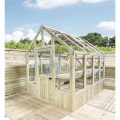 | 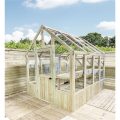 | 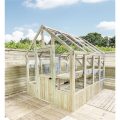 | 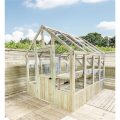 | 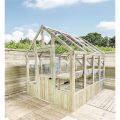 | |
| Expert Score | 63 | 68 | 63 | 70 | 73 |
|---|---|---|---|---|---|
| Price | £13,242.15 | £10,791.87 | £13,847.05 | £9,399.30 | £8,510.59 |
| Size | 30' x 6' | 24' x 8' | 30' x 8' | 22' x 6' | 20' x 6' |
| Brand | Marlborough Greenhouses | Marlborough Greenhouses | Marlborough Greenhouses | Marlborough Greenhouses | Marlborough Greenhouses |
| Material | Wooden | Wooden | Wooden | Wooden | Wooden |
| Cladding Thickness | 12mm | 12mm | 12mm | 12mm | 12mm |
| Guarantee | 10 Years | 10 Years | 10 Years | 10 Years | 10 Years |
| Go | Go | Go | Go | Go |
Similar Categories
Wooden GreenhousesSources
Merchants Checked
12 different sources were used to research information on this product, and 4 contained information that we were able to use to compile the data used on this page.
The following merchants were checked on the 06 August, 2022 to see if they stocked this product.
ManoMano UK – 922302 products checked, found 1 match.
Wilko.com – 21232 products checked, found 1 match.
Homebase – 35509 products checked, found 1 match.
sheds.co.uk – 1999 products checked, found 1 match.
Waltons – 231 products checked, found no matches.
Wickes – 19576 products checked, found no matches.
B&Q – 78905 products checked, found no matches.
Buy Sheds Direct – 1635 products checked, found no matches.
BillyOh – 1244 products checked, found no matches.
Garden Buildings Direct – 1284 products checked, found no matches.
Shedstore – 1373 products checked, found no matches.
Tiger Sheds – 635 products checked, found no matches.
1. Dip Treated: Dip treating is a temporary protective base coat treatment that is mainly designed to help protect the building during transit and for around one month after it is assembled. This water-based treatment is the least time-consuming and cheapest type of wood treatment. It involves dipping the wood in a protective water-based preservative and then leaving it to dry. The action of dipping is where ‘dip treatment’ comes from.
A dip-treated garden building is not considered fully treated with wood preservatives; it’s vital to re-treat your dip-treated building, preferably with a solvent-based (or oil-based) wood treatment. Then re-treat it on an annual basis using a solvent-based (or oil-based) wood treatment.
If you don’t want to treat something on an annual basis then a pressure treated wooden building might be a better option, this is where the wood undergoes a process called tanalisation (pressure treatment) during production. This is where the timber is submerged in specialist wood preservatives (such as Tanalith E, this is actually the origin of the word ‘tanalisation’), the wood then goes into a high pressure vacuum tank to draw out excess moisture and air and force in the preservatives. This deep penetration of the exterior wood protects it from the elements and all forms of insect attack. Wood treated this way can last many years without being re-treated. The Wood Protection Association has a good article/video on this. ↩
2. Styrene (Polystyrene (High Impact) HIPS): Styrene as it is commonly known or High Impact Polystyrene (HIPS) is a very versatile form of plastic. It has a very wide range of uses but for garden buildings styrene is typically used as a budget option for windows.
Styrene is a shatter-resistant material, which is why it is ideal for situations where safety needs to be considered, such as playhouses. This benefit can be offset by a few other drawbacks, unfortunately styrene has a tendency to yellow over time (the technical term is Photoyellowing and it is caused by prolonged exposure to UV Light), the degradation of its polymers over time also causes it to become more brittle.
Another drawback of styrene is its thermal coefficient of expansion (it is 80 x 10-6), this is higher than most other glazing options. This means that as the material heats up and cools it can contract and expand more than other glazing options. This cycle can lead to a loose fit of windows over time.
According to data from the British Plastics Fedaration the physical properties of Styrene (Polystyrene (High Impact) are that it is not very good when exposed to high heat with a maximum continuous use temperature of between 60 to 80 °C. This is coupled with the fairly low range the Notched Impact Strength data shows of 10.0 – 20.0 Kj/m². ↩
3. Cladding types identified: shiplap tongue & groove ↩
4. Global cladding data sourced from: All shiplap tongue & groove greenhouses ↩
5. Top cladding data sourced from: Top 78 shiplap tongue & groove greenhouses ↩
6. 6′ x 7′ cladding data sourced from: 14 6′ x 7′ shiplap tongue & groove greenhouses ↩
8. Global cladding thickness data sourced from: All 12mm greenhouses ↩
9. Top cladding thickness data sourced from: Top 78 12mm greenhouses ↩
10. 6′ x 7′ cladding thickness data sourced from: 1 6′ x 7′ 12mm greenhouses ↩
11. Roof material types identified: styrene ↩
12. Glazing material types identified: styrene ↩

